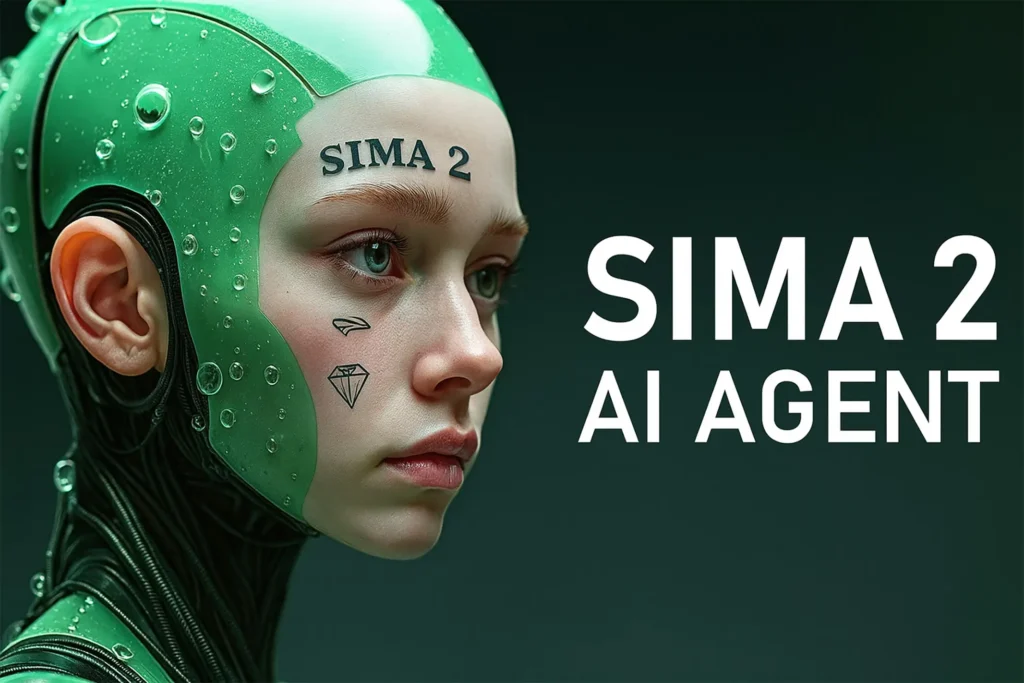The evolution of artificial intelligence is rushing toward agents that can reason, interact, and adapt like real human players. SIMA 2, developed as an advanced multimodal, embodied AI system, represents a groundbreaking leap in how machines understand and operate inside complex 3D virtual environments. Unlike traditional game AIs programmed with fixed actions, SIMA 2 exhibits generalised learning across different worlds, allowing it to perform tasks naturally, collaborate with players, and improve through experience.
In this comprehensive analysis, we explore how SIMA 2 plays, reasons, and learns—revealing why it stands among the most advanced AI agents ever designed for virtual worlds.
Understanding SIMA 2: A New Era of Embodied AI
SIMA 2 is engineered as a universal game-playing agent, capable of interpreting instructions, observing its environment, and taking appropriate actions in real-time. It uses vision–language models, reinforcement learning, and simulation-driven training to operate across multiple games and 3D environments without custom coding.
Unlike scripted bots, SIMA 2 does not rely on predefined patterns. Instead, it:
- Interprets visual scenes using multimodal perception
- Understands natural language tasks
- Plan actions step-by-step
- Learns from failures and successes
- Generalises skills across different game engines
This level of adaptability gives SIMA 2 an unprecedented edge in interacting with dynamic worlds.
How SIMA 2 Plays: Real-Time Action and Adaptation
1. Human-Like Gameplay Behaviours:
SIMA 2 demonstrates behaviour similar to that of a trained human player. It can:
- Navigate complex terrain
- Avoid hazards
- Manipulate objects
- Solve in-game puzzles
- Execute multi-step tasks
Such behaviour is driven by the agent’s ability to perceive the environment with a high level of detail and convert that information into meaningful action.
2. Continuous Observation and Decision Loops:
SIMA 2 operates using rapid observation–action cycles:
- Visual Input – Reads the environment frame-by-frame
- Context Understanding – Recognises goals, threats, and resources
- Action Planning – Predicts the best next move
- Execution – Acts precisely
- Evaluation – Measures output and adjusts accordingly
These cycles allow SIMA 2 to react in real time, whether dodging obstacles or building structures.
3. Cross-Platform Game Competency:
One of SIMA 2’s most significant strengths is its ability to operate across various 3D environments:
- Sandbox games
- Open-world simulations
- Adventure and puzzle games
- Physics-driven environments
The agent does not need new training for each world. It uses generalised action representations to maintain consistent performance.
How SIMA 2 Reasons: Built-In Intelligence and Strategy
1. Multi-Step Logical Reasoning:
SIMA 2 excels in understanding and planning long-horizon tasks, such as:
- Gathering materials and crafting items
- Organising inventory systems
- Constructing multi-layer structures
- Following multi-phase missions
The AI performs internal reasoning by breaking complex tasks into smaller steps, similar to a human’s thought process.
2. Robust Language Interpretation:
SIMA 2 can interpret detailed player instructions, even when phrased conversationally. It understands:
- Intent
- Context
- Objectives
- Implicit requirements
This lets players simply tell the AI what to do—no manual commands or programming needed.
3. Contextual Awareness and Problem Solving:
The AI uses world modelling to predict outcomes. If a bridge is required to cross a river or a tool is missing for a task, SIMA 2 identifies the problem and finds the solution autonomously.
It reasons through:
- Spatial relationships
- Resource availability
- Environmental constraints
- Outcome probabilities
This intelligent decision-making sets SIMA 2 apart from traditional NPCs.
How SIMA 2 Learns: Training for Real-World-like Intelligence
1. Multimodal Training Pipelines:
SIMA 2 is trained using a combination of:
- 3D simulation environments
- Human demonstration data
- Reinforcement learning
- Self-improvement iteration cycles
The agent observes how humans act in virtual worlds and learns patterns that shape its own behaviour.
2. Scalability and Skill Transfer:
A standout capability of SIMA 2 is its ability to transfer skills across games. Lessons learned in one environment—such as item gathering or obstacle navigation—benefit performance in another.
This kind of skill portability makes SIMA 2 vastly more efficient than traditional game AIs that must be reprogrammed for each title.
3. Long-Term Memory and Behaviour Refinement:
The AI uses memory modules to store previous experiences and continually refine:
- Movement precision
- Resource management
- Task efficiency
- Strategic decisions
Over time, SIMA 2 becomes significantly better at gameplay than at the start of training.
Real-World Applications of SIMA 2 Beyond Gaming
Although SIMA 2 is designed for virtual worlds, its capabilities have far-reaching implications.
1. Robotics and Autonomous Systems:
The agent’s ability to navigate 3D spaces and manipulate objects can transfer to:
- Household robots
- Industrial automation
- Disaster response bots
With domain adaptation, SIMA 2-like models could control physical machines in the future.
2. Synthetic Training for Workforce Automation:
Industry professionals can train AI for tasks like logistics or construction using simulated worlds. This reduces risk and cost.
3. Virtual Assistants and NPC Evolution:
SIMA 2 unlocks next-generation NPC behaviour:
- Smart companions
- Quest assistants
- Dynamic world builders
These AI characters can create more immersive gameplay experiences.
Why SIMA 2 Represents the Future of AI in 3D Worlds
SIMA 2 is more than a game-playing bot. It is a glimpse into the future of embodied intelligence, where AI agents can understand, act, and learn from environments in ways similar to human players.
By combining vision, reasoning, language, and motor control, SIMA 2 proves that interactive AI can reach a new level of capability—far beyond scripted logic or rule-based behaviour.
Its power lies in:
- Generalisation across worlds
- Adaptability to new tasks
- Intelligent reasoning
- Complex decision-making
- Multimodal learning
As development continues, SIMA 2 and similar agents will shape the future of gaming, robotics, simulation training, and real-world AI applications.

